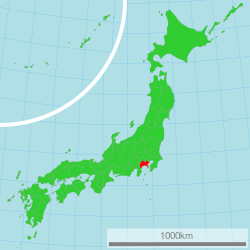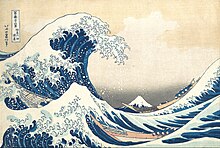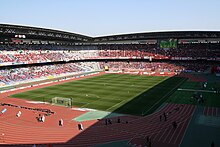Kanagawa Prefecture
This articleneeds additional citations forverification.(March 2020) |
Kanagawa Prefecture
Kanagawa huyện | |
|---|---|
| Japanese transcription(s) | |
| •Japanese | Kanagawa huyện |
| •Rōmaji | Kanagawa-ken |
 Minato Mirai 21commercial area is located betweenNishiandNakadistricts,Yokohamacity, Kanagawa prefecture at sunset.Mount Fujiappears on the horizon | |
| Anthem:Hikari arata ni | |
 | |
| Coordinates:35°26′51.03″N139°38′32.44″E/ 35.4475083°N 139.6423444°E | |
| Country | |
| Region | Kantō |
| Island | Honshu |
| Capital | Yokohama |
| Subdivisions | Districts:6,Municipalities:33 |
| Government | |
| •Governor | Yūji Kuroiwa(since April 2011) |
| Area | |
| • Total | 2,415.83 km2(932.76 sq mi) |
| • Rank | 43rd |
| Highest elevation | 1,675 m (5,495 ft) |
| Population (October 1, 2015) | |
| • Total | 9,058,094 |
| • Rank | 2nd |
| • Density | 3,770/km2(9,800/sq mi) |
| • Dialect | Kanagawa dialect |
| GDP | |
| • Total | JP¥35,205 billion US$323.0 billion (2019) |
| ISO 3166 code | JP-14 |
| Website | www |
| Symbols of Japan | |
| Bird | Common gull(Larus canus) |
| Flower | Golden-rayed lily(Lilium auratum) |
| Tree | Ginkgo(Ginkgo biloba) |

Kanagawa Prefecture(Kanagawa huyện,Kanagawa-ken)is aprefectureofJapanlocated in theKantō regionofHonshu.[2]Kanagawa Prefecture is thesecond-most populous prefectureof Japan at 9,221,129 (1 April 2022) and third-densest at 3,800 inhabitants per square kilometre (9,800/sq mi). Its geographic area of 2,415 km2(932 sq mi) makes it fifth-smallest. Kanagawa Prefecture bordersTokyoto the north,Yamanashi Prefectureto the northwest andShizuoka Prefectureto the west.
Yokohamais the capital and largest city of Kanagawa Prefecture and thesecond-largest cityin Japan, with other major cities includingKawasaki,Sagamihara,andFujisawa.[3]Kanagawa Prefecture is located on Japan's easternPacific coastonTokyo BayandSagami Bay,separated by theMiura Peninsula,across fromChiba Prefectureon theBōsō Peninsula.Kanagawa Prefecture is part of theGreater Tokyo Area,the most populousmetropolitan areain the world, with Yokohama and many of its cities being major commercial hubs and southernsuburbsof Tokyo. Kanagawa Prefecture was the political and economic center of Japan during theKamakura periodwhenKamakurawas thede factocapital and largest city of Japan as the seat of theKamakura shogunatefrom 1185 to 1333. Kanagawa Prefecture is a popular tourist area in the Tokyo region, with Kamakura andHakonebeing two popular side trip destinations.
History
[edit]The prefecture has some archaeological sites going back to theJōmon period(around 400 BCE). About 3,000 years ago,Mount Hakoneproduced a volcanic explosion which resulted inLake Ashion the western area of the prefecture.[citation needed]
It is believed[by whom?]that theimperial dynastyruled this area from the 5th century onwards. In theancient era,its plains were very sparsely inhabited.[citation needed]
In medieval Japan, Kanagawa was part of the provinces ofSagamiandMusashi.[4]Kamakurain central Sagami was the capital of Japan during theKamakura period(1185–1333).
During theEdo period,the western part of Sagami Province was governed by thedaimyōofOdawara Castle,while the eastern part was directly governed by theTokugawa shogunateinEdo(modern-day Tokyo).[citation needed]
CommodoreMatthew Perrylanded in Kanagawa in 1853 and 1854 and signed theConvention of Kanagawato force open Japanese ports to the United States.Yokohama,the largest deep-water port inTokyo Bay,was opened to foreign traders in 1859 after several more years of foreign pressure, and eventually developed into the largest trading port in Japan. NearbyYokosuka,closer to the mouth of Tokyo Bay, developed as a naval port and now serves as headquarters for theU.S. 7th Fleetand the fleet operations of theJapan Maritime Self-Defense Force.After theMeiji period,many foreigners lived in Yokohama City, and visitedHakone.TheMeiji governmentdeveloped the first railways in Japan, fromShinbashi(in Tokyo) to Yokohama in 1872.[citation needed]
The epicenter of the1923 Great Kantō earthquakewas deep beneathIzu ŌshimaIsland in Sagami Bay. It devastated Tokyo, the port city ofYokohama,surrounding prefectures ofChiba,Kanagawa,andShizuoka,and caused widespread damage throughout theKantō region.[5]The sea receded as much as 400 metres from the shore atManazuru Point,and then rushed back towards the shore in a great wall of water which swamped Mitsuishi-shima.[6]AtKamakura,the total death toll from earthquake, tsunami, and fire exceeded 2,000 victims.[7]AtOdawara,ninety percent of the buildings collapsed immediately, and subsequent fires burned the rubble along with anything else left standing.[8]
Yokohama,Kawasaki,and other major cities were heavily damaged by the U.S. bombing in 1945. Total casualties amounted to more than several thousand. After the war, GeneralDouglas MacArthur,theSupreme Commander of the Allied Powersfor theOccupation of Japan,landed in Kanagawa, before moving to other areas. U.S. military bases still remain in Kanagawa, includingCamp Zama(Army),Yokosuka Naval Base,Naval Air Facility Atsugi(Navy).[9]
Demographics
[edit]
| Year | Pop. | ±% p.a. |
|---|---|---|
| 1890 | 979,756 | — |
| 1903 | 1,051,433 | +0.54% |
| 1913 | 1,228,254 | +1.57% |
| 1920 | 1,323,390 | +1.07% |
| 1925 | 1,416,792 | +1.37% |
| 1930 | 1,619,606 | +2.71% |
| 1935 | 1,840,005 | +2.58% |
| 1940 | 2,188,974 | +3.53% |
| 1945 | 1,865,667 | −3.15% |
| 1950 | 2,487,665 | +5.92% |
| 1955 | 2,919,497 | +3.25% |
| 1960 | 3,443,176 | +3.35% |
| 1965 | 4,430,743 | +5.17% |
| 1970 | 5,472,247 | +4.31% |
| 1975 | 6,397,748 | +3.17% |
| 1980 | 6,924,348 | +1.59% |
| 1985 | 7,431,974 | +1.43% |
| 1990 | 7,980,391 | +1.43% |
| 1995 | 8,245,900 | +0.66% |
| 2000 | 8,489,974 | +0.59% |
| 2005 | 8,791,597 | +0.70% |
| 2010 | 9,048,331 | +0.58% |
| 2015 | 9,058,094 | +0.02% |
| source:[10] | ||
In 1945, Kanagawa was the 15th most populous prefecture in Japan, with the population of about 1.9 million. In the years after the war, the prefecture underwent rapid urbanization as a part of the Greater Tokyo Area. The population as of September 1, 2014[update]is estimated to be 9.1 million.[11]Kanagawa became the second most populous prefecture in 2006.
Geography
[edit]

Kanagawa is a relatively small prefecture located at the southeastern corner of theKantō Plain[12]wedged between Tokyo on the north, the foothills ofMount Fujion the northwest, and theSagami Bay[12]andTokyo Bayon the south and east. The eastern side of the prefecture is relatively flat and heavily urbanized, including the large port cities ofYokohamaandKawasaki.
The southeastern area nearby theMiura Peninsulais less urbanized, with the ancient city ofKamakuradrawing tourists to temples and shrines. The western part, bordered byYamanashi PrefectureandShizuoka Prefectureon the west,[13]is more mountainous and includes resort areas likeOdawaraandHakone.The area, stretching 80 kilometres (50 mi) from west to east and 60 kilometres (37 mi) from north to south, contains 2,400 square kilometres (930 sq mi) of land, accounting for 0.64% of the total land area of Japan.[13]
As of 1 April 2012[update],23% of the total land area of the prefecture was designated asNatural Parks,namely theFuji-Hakone-Izu National Park;Tanzawa-Ōyama Quasi-National Park; andJinba Sagamiko,Manazuru Hantō,Okuyugawara,andTanzawa-ŌyamaPrefectural Natural Parks.[14]
Topography
[edit]Topographically, the prefecture consists of three distinct areas. The mountainous western region features theTanzawa Mountain Rangeand the volcanoMount Hakone.The hilly eastern region is characterized by theTama HillsandMiura Peninsula.The central region, which surrounds the Tama Hills and Miura Peninsula, consists of flat stream terraces and low lands around major rivers including theSagami River,Sakai River,Tsurumi River,andTama River.[13]
TheTama Riverforms much of the boundary between Kanagawa and Tokyo. TheSagami Riverflows through the middle of the prefecture. In the western region, the Sakawa runs through a small lowland, the Sakawa Lowland, between Mount Hakone to the west and the Ōiso Hills to the east, and flows into Sagami Bay.[12]
The Tanzawa Mountain Range, part of the Kantō Mountain Range, containsMount Hiru(1,673 m or 5,489 ft), the highest peak in the prefecture. Other mountains measure similar mid-range heights: Mount Hinokiboramaru (1,601 m or 5,253 ft),Mount Tanzawa,(1,567 m or 5,141 ft),Mount Ōmuro(1,588 m or 5,210 ft), Mount Himetsugi (1,433 m or 4,701 ft), andMount Usu(1,460 m or 4,790 ft). The mountain range is lower in height southward leading to Hadano Basin to the Ōiso Hills. At the eastern foothills of the mountain range lies the Isehara Plateau and across the Sagami River theSagamino plateau.[12]
Cities
[edit]
Government Ordinance Designated CityCityTownVillage
Nineteen cities are located in Kanagawa Prefecture.
Towns and villages
[edit]
These are the towns and villages in eachdistrict:
Mergers
[edit]Festivals and events
[edit]
- Tama River Firework event
- Yokohama Port Anniversary Festival (June)
- Kamakura Festival (April)
- Hiratsuka Tanabata Festival (July)
- Odawara Hōjō Godai Festival (May)[15][16]
- Yugawara Kifune Festival (July)
- Chigasaki Hamaori Festival (July)
Transportation
[edit]Kanagawa's transport network is heavily intertwined with that of Tokyo (see:Transportation in Greater Tokyo).Shin-YokohamaandOdawarastations on theTōkaidō Shinkansenare located in the prefecture, providing high-speed rail service to Tokyo, Nagoya, Osaka, and other major cities.
Railways
[edit]- East Japan Railway Company
- Central Japan Railway Company
- Keikyu
- Odakyu
- Sagami Railway
- Tokyu
- Minatomirai Line
- Keio
- Izuhakone Railway
- Enoshima Electric Railway
Subways
[edit]- Yokohama Municipal Subway
- Blue Line
- Green Line
Monorail
[edit]People movers
[edit]Road
[edit]Expressway
[edit]National highways
[edit]- Route 1
- Route 15
- Route 16
- Route 20
- Route 129(Hiratsuka-Atsugi-Sagamihara)
- Route 132
- Route 133
- Route 134
- Route 135(Shimoda–Atami-Odawara)
- Route 138
- Route 246(Chiyoda, Tokyo-Kawasaki-Machida-Atsugi-Isehara-Gotenba–Numazu)
- Route 255
- Route 357(Chiba–Funabashi–Daiba of Tokyo-Yokohama-Yokosuka)
- Route 409
- Route 412
- Route 413(Fujiyoshida–Lake Yamanaka-Sagamihara)
- Route 466(Setagaya, Tokyo-Kawasaki-Yokohama)
- Route 467
Ports
[edit]- Yokohama Port– International container hub port
- Misaki Port – Ferry Route toKisarazu
Education
[edit]TheKanagawa Prefectural Board of Educationmanages and oversees individual municipal school districts. The board of education also directly operates most of the public high schools in the prefecture.
University facilities
[edit]- Kawasaki
- Keio University– Shin Kawasaki Campus
- Meiji University– Ikuta Campus
- Senshu University– Ikuta Campus
- Japan Women's University
- Showa University of Music
- Den-en Chofu University– Aso Ward
- Nippon Medical School
- St. Marianna University, School of Medicine – Miyamae
- Japan Cinema School
- Tokyo City University– Aso Ward
- Yokohama
- Tokyo Institute of Technology– Suzukakedai
- Tokyo University of the Arts– Naka Ward
- Yokohama National University– Hodogaya
- Yokohama City University– Kanazawa Ward
- Kanagawa University– Kanagawa Ward
- Kanto Gakuin University– Kanazawa Ward
- Toin University of Yokohama– Aoba Ward
- Tsurumi University– Tsurumi Ward
- Yokohama College of Commerce– Tsurumi Ward
- Yokohama College of Pharmacy– Totsuka Ward
- Keio University– Hiyoshi Campus
- Tokyo City University – Tsuzuki Ward
- Meiji Gakuin University– Totsuka Ward
- Nippon Sport Science University– Aoba Ward
- Toyo Eiwa University– Midori Ward
- Kokugakuin University– Tama Plaza
- Senzoku Gakuen College of Music
- Sagamihara
- Aoyama Gakuin University
- Azabu University
- Kitasato University
- Sagami Women's University
- Obirin University
- Joshi University of Art and Design
- Teikyo University
- Yokosuka
- Hiratsuka
- Tokai University– Hiratsuka Campus
- Shoin University– Hiratsuka Campus
- Kanagawa University
- Isehara
- Tokai University – Isehara Campus
- Sanno University
- Odawara
- Kanto Gakuin University – Odawara Campus
- International University of Health and Welfare
- Chigasaki
- Bunkyo University– Chigasaki Campus
- Atsugi
- Shoin University
- Tokyo University of Agriculture– Atsugi Campus
- Kanagawa Institute of Technology
- Tokyo Polytechnic University– Atsugi Campus
- Hayama
Sports
[edit]
Facilities
[edit]Football and athletics
[edit]- Nissan Stadium (International Stadium Yokohama)—in Yokohama, the final venue of2002 FIFA World Cup,FIFA Club World Cupin 2005–2007 and2019 Rugby World Cup
- Nippatsu Mitsuzawa Stadium (Mitsuzawa Stadium)—in Yokohama, only for football
- Todoroki Athletics Stadium—in Kawasaki, the final venue of2007 IFAF World Cup(American football).
- Hiratsuka Athletics Stadium
Baseball
[edit]- Yokohama Stadium—for baseball (Yokohama DeNA BayStars) and hostedAustralian rules football
- Kawasaki Stadium—former homeground of Taiyo Whales (now Yokohama BayStars) and Lotte Orions (nowChiba Lotte Marines).
- Yokosuka Stadium—home field ofShonan Searex,minor league team ofYokohama BayStars
Indoor
[edit]- Yokohama Arena—also for music concert
- Yokohama Cultural Gymnasium—a volleyball venue of1964 Summer Olympicsin Tokyo
- Todoroki Arena—in Kawasaki and multi-purpose venue (including basketball)
- Odawara Arena—2020 Kanagawa Pre-Games training facilities
Other
[edit]- EnoshimaYachtCourse—used for 1964 Summer Olympics.
- Hakone EkidenCourse—from Tokyo toHakone,108.0 km, mostly onJapan National Route 1andRoute 15.Runners run on the divided route for ten parts on January 2 (to Hakone) and January 3 (to Tokyo) every year.
- Lake Sagami—hostedcanoeingandrowingfor the 1964 Summer Olympics.
Teams
[edit]Soccer (football)
[edit]- Kawasaki Frontale(Kawasaki)—Todoroki Athletics
- Yokohama F. Marinos(Yokohama,Yokosuka)—Nissan Stadium
- Yokohama F.C.(Yokohama)—Mitsuzawa Ballpark
- Shonan Bellmare(Hiratsuka,Odawaraand some cities and towns in central and western area of Kanagawa)—Hiratsuka Athletic Stadium (football) and Odawara Arena (futsal)
Baseball
[edit]- Yokohama BayStars(Yokohama)—Yokohama Stadium, and Yokosuka Stadium (for its farm team, "Shonan Searex").
Basketball
[edit]Volleyball
[edit]- NEC Red Rockets(Kawasaki)—Todoroki Arena
Visitors attractions and places of interest
[edit]Sister areas
[edit]Kanagawa Prefecture has sister relationships with these places: [17]
 Maryland,United States (1981)
Maryland,United States (1981) Liaoning Province,China (1983)
Liaoning Province,China (1983) Odesa Oblast,Ukraine (1986)
Odesa Oblast,Ukraine (1986) Baden-Württemberg,Germany (1989)
Baden-Württemberg,Germany (1989) Gyeonggi Province,Republic of Korea (1990)
Gyeonggi Province,Republic of Korea (1990) Queensland,Australia (1990)
Queensland,Australia (1990) Penang,Malaysia (1991)
Penang,Malaysia (1991) Västra Götaland County,Sweden (1998)
Västra Götaland County,Sweden (1998) Aguascalientes,México (2013)[18]
Aguascalientes,México (2013)[18]
In popular culture
[edit]- Stephen Sondheim's stage musicalPacific Overtures,about the "opening" of Japan to Western influence byCommodore Perry,contains the song "Welcome to Kanagawa".
- The main team in the JapanesemangaandanimeseriesSlam Dunk,Shohoku, is from Kanagawa.
- The Hinata Inn and surrounding town from themangaandanimeseriesLove Hinaare located in Kanagawa.
- The JapanesemangaseriesElfen Liedtakes place in Kanagawa, mainly in Kamakura and Enoshima (Fujisawa).
- The JapaneseanimeseriesS-CRY-EDtakes place in Kanagawa Prefecture, after a seismic event raises it from the ground.
- The JapanesemangaandanimeseriesKenkō Zenrakei Suieibu Umishōtakes place in the fictional Kanagawa city of Umineko.
- The JapaneseanimeseriesGundam Wing's early episodes feature Kanagawa prominently, mainly Yokohama and Yokosuka.
- The JapaneseanimeandmangaseriesArea no Kishitakes place in Kanagawa, mostly Kamakura.
- The JapaneseanimeandmangaseriesAnonymous Noisetakes place in Kanagawa, mostly Kamakura (Kamakura Yuigahama Beach).
- The JapaneseanimeandmangaseriesHamatoratakes place in Kanagawa, mainly in Yokohama.
- The JapaneseanimeandmangaseriesHis and Her Circumstancestakes place in Kanagawa Prefecture, mainly inKawasakicity andYokohama.
- The JapaneseanimeandmangaseriesNeon Genesis Evangeliontakes place in Tokyo-3, which is located in the village ofHakone,in theAshigarashimo District
- A team from the JapaneseanimeandmangaseriesKuroko's Basketball,Kaijo, is from Kanagawa.
- The mangaShonan Junai Gumi,along with its prequelBad Company,and the sequelGreat Teacher Onizuka's spin offGTO: 14 Days in Shonan,are set in Shonan, in Kanagawa
- The JapaneseanimeandmangaseriesYowamushi Pedal,Hakone Academy is from Hakone, Kanagawa.
- The JapaneseanimeandmangaseriesInitial DFifth Stage is set in Kanagawa, and Final Stage is set inHakone.
- The JapaneseanimeandmangaseriesBungo Stray Dogsis set in Yokohama.
- The JapaneseanimeandmangaseriesAoi Hanais set in Kamakura.
- The JapaneseanimeandmangaseriesRascal Does Not Dream of Bunny Girl Senpaitakes place in various places in Kanagawa Prefecture, such asFujisawaandYokohama.
- The JapaneseanimeandmangaseriesAstro Fighter Sunredis set in Kanagawa Prefecture, specificallyKawasaki Cityand the area around theTama River.
See also
[edit]Citations
[edit]- ^"2020 niên độ quốc dân kinh tế tính toán ( 2015 năm tiêu chuẩn cơ bản ・2008SNA ): Kinh tế xã hội tổng hợp viện nghiên cứu - Nội Các phủ".Nội Các phủ ホームページ(in Japanese).Retrieved2023-05-18.
- ^Nussbaum, Louis-Frédéric. (2005). "Kanagawa" inJapan Encyclopedia,p. 466,p. 466, atGoogle Books;"Kantō" inp. 479,p. 479, atGoogle Books.
- ^Nussbaum, "Yokohama" inpp. 1054–1055,p. 154, atGoogle Books.
- ^Nussbaum, "Provinces and prefectures" inp. 466,p. 466, atGoogle Books.
- ^Hammer, Joshua. (2006).Yokohama Burning: the Deadly 1923 Earthquake and Fire that Helped Forge the Path to World War II,p. 278,p. 278, atGoogle Books.
- ^Hammer,pp. 114–115,p. 114, atGoogle Books.
- ^Hammer,pp. 115-116,p. 115, atGoogle Books.
- ^Hammer,p. 113,p. 113, atGoogle Books.
- ^"Naval Air Facility Atsugi".
- ^"Statistics Bureau Home Page".stat.go.jp.
- ^Kanagawa huyện dân cư thống kê điều tra công biểu tư liệu(Report). 2014.Archivedfrom the original on 2014-10-13.
- ^abcdKanagawa terrain(in Japanese)(Translateto English:Google,Bing,Yandex)
- ^abcOverview of the prefectural geography(in Japanese)(Translateto English:Google,Bing,Yandex)
- ^"General overview of area figures for Natural Parks by prefecture"(PDF).Ministry of the Environment.Archived(PDF)from the original on 21 April 2012.Retrieved16 August2012.
- ^"Tiểu điền nguyên thị | đệ 59 hồi tiểu điền nguyên bắc điều năm đời tế り".
- ^"5 nguyệt 3 ngày bắc điều năm đời tế り | イベント- trong năm một lãm | リトルトリップ tiểu điền nguyên [ tiểu điền nguyên thị quan quang hiệp hội ]".リトルトリップ tiểu điền nguyên [ tiểu điền nguyên thị quan quang hiệp hội ].
- ^"Friendly/Sister Affiliations of Kanagawa Prefecture and the Municipalities: Kanagawa".Kanagawa Prefectural Government. February 1, 2016.Archivedfrom the original on July 19, 2016.RetrievedJuly 17,2016.
- ^"Memorándum de Entendimiento entre el Estado de Aguascalientes, de los Estados Unidos Mexicanos, y el Gobierno de la Prefectura de Kanagawa, Japón"(PDF).Archived(PDF)from the original on 2017-12-04.Retrieved2017-12-04.
General references
[edit]- Hammer, Joshua (2006).Yokohama Burning: The Deadly 1923 Earthquake and Fire that Helped Forge the Path to World War II.New York: Simon & Schuster.ISBN9780743264655;OCLC67774380.
- Nussbaum, Louis-Frédéric and Käthe Roth (2005).Japan Encyclopedia.Cambridge: Harvard University Press.ISBN978-0-674-01753-5;OCLC58053128.
External links
[edit]- Kanagawa Prefecture Official Website(in Japanese)
- Kanagawa Prefecture Tourism Website(in English)
 Geographic data related toKanagawa PrefectureatOpenStreetMap
Geographic data related toKanagawa PrefectureatOpenStreetMap



